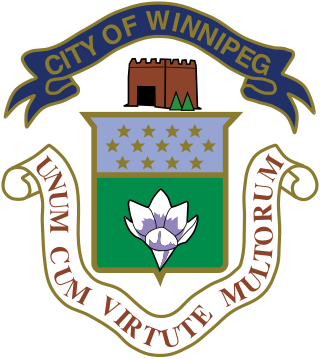
The North American Vexillological Association (NAVA) is a membership organization devoted to vexillology, the study of flags. It was founded in 1967 by American vexillologist Whitney Smith, and others. Its membership of 1,100+ comprises flag scholars, enthusiasts, designers, collectors, conservators, educators, merchants, manufacturers, historians, and hobbyists from most states and provinces of the United States and Canada, and more than 30 other countries.
KTWU is a PBS member television station in Topeka, Kansas, United States, owned by Washburn University. The station's studios are located on the western edge of the Washburn University campus at 19th Street and Jewell Avenue in central Topeka, and its transmitter is located on Wanamaker Road on the city's northwest side.

The Great Seal of the State of Illinois is the official emblem of the U.S. state of Illinois, and signifies the official nature of a document produced by the state. The present seal was designed and proposed in 1868 and officially adopted in 1869. It depicts in profile a bald eagle perched on a rock with wings spread and holding a shield, with a banner in its beak and sunrise over water in the background. It replaced an earlier seal that was almost the same as the Great Seal of the United States, adopted when Illinois became a state in 1818.

KSNT is a television station in Topeka, Kansas, United States, affiliated with NBC. It is owned by Nexstar Media Group alongside low-power, Class A Fox affiliate KTMJ-CD ; Nexstar also provides certain services to dual ABC/CW+ affiliate KTKA-TV under joint sales and shared services agreements (JSA/SSA) with Vaughan Media, LLC. The stations share studios on Northwest 25th Street, near the unincorporated community of Kiro, where KSNT's transmitter is also located.

KTKA-TV is a television station in Topeka, Kansas, United States, affiliated with ABC and The CW Plus. It is owned by Vaughan Media, LLC, which maintains joint sales and shared services agreements (JSA/SSA) with Nexstar Media Group, owner of NBC affiliate KSNT and Fox affiliate KTMJ-CD, for the provision of certain services. The stations share studios on Northwest 25th Street, near the unincorporated community of Kiro ; KTKA-TV's transmitter is located along West Union Road west of Topeka.

WIBW-TV is a television station in Topeka, Kansas, United States, affiliated with CBS and MyNetworkTV. Owned by Gray Television, the station maintains studios on Commerce Place in west-southwestern Topeka, and its transmitter is located on Windy Hill Road in Maple Hill.

The Topeka & Shawnee County Public Library is a public library located in Topeka, Kansas, United States. It serves all of Shawnee County, Kansas with the exception of the Rossville, Kansas and Silver Lake, Kansas townships. The Topeka & Shawnee County Public Library is a municipal taxing district authorized by Kansas law. It is governed by a board of trustees consisting of ten members.

KTMJ-CD is a low-power, Class A television station in Topeka, Kansas, United States, affiliated with the Fox network. It is owned by Nexstar Media Group alongside NBC affiliate KSNT ; Nexstar also provides certain services to dual ABC/CW+ affiliate KTKA-TV under joint sales and shared services agreements (JSA/SSA) with Vaughan Media, LLC. The stations share studios on Northwest 25th Street, near the unincorporated community of Kiro ; KTMJ-CD's transmitter is located along Southwest West Union Road west of Topeka.

WIBW-FM is a commercial FM radio station in Topeka, Kansas. It is owned by Alpha Media and airs a country radio format. The studios and offices are on SW Executive Drive in Topeka. The transmitter is off Windy Hill Road in Maple Hill. WIBW-FM broadcasts at 100,000 watts.
The Country Stampede Music Festival is an outdoor country music and camping festival held at Heartland Motorsports Park, south of Topeka, Kansas. The festival has been held annually since 1996, historically on the last weekend in June.
WIBW is a commercial AM radio station in Topeka, Kansas. It is owned by Alpha Media and airs a talk and sports radio format. The studios and offices are on SW Executive Drive in Topeka. The transmitter is off NW Landon Road in Silver Lake.

Devin Scillian is a former American television journalist, musician and children's author.

The coat of arms of Winnipeg is the full armorial achievement as used by the municipal government as an official symbol. The present coat of arms were granted through a letter patent from the College of Arms in 1979.
Topeka Metro is the fixed-route and paratransit public transportation operator in the city of Topeka, Kansas. It carries passengers Monday through Saturday on 12 routes on weekdays and on Saturdays. Topeka Metro also runs a paratransit service during its service hours.
West Ridge Mall is an enclosed shopping mall in Topeka, Kansas. The mall has three open anchor stores: Dillard's, Furniture Mall of Kansas, and JCPenney. There are two vacant anchors that were formerly Sears and Burlington. It is the third largest enclosed mall in the state of Kansas, behind Oak Park Mall in Overland Park and Towne East Square in Wichita.

Michelle De La Isla is an American politician who served as the mayor of Topeka, Kansas from 2018 to 2022. She previously served on the Topeka City Council from 2013 to 2018. De La Isla was the city's first Latina and single mother to serve as mayor. She was the Democratic nominee for Kansas's 2nd congressional district in the 2020 election, but lost.

Steven Charles Watkins Jr. is an American politician and former military officer. He served as the U.S. representative for Kansas's 2nd congressional district from 2019 to 2021. He is a member of the Republican Party, and was succeeded by Jake LaTurner. He earned degrees from the United States Military Academy at West Point, Massachusetts Institute of Technology (M.I.T.), and Harvard.

David C. Toland is an American politician and businessman concurrently serving as the 52nd lieutenant governor of Kansas and Kansas secretary of commerce.

The Topeka Tropics were a professional indoor football based in Topeka, Kansas, and played their home games at the Stormont Vail Events Center. The team originally folded after its inaugural 2022 season, but was renewed under new ownership before the 2023 season. The Tropics a were the third indoor football team to be based in Topeka following the Topeka Knights/Kings (1999–2000) and the Kansas Koyotes (2003–2014).

The 2022 Kansas Attorney General election took place on November 8, 2022, to elect the Attorney General of Kansas. Incumbent Republican Attorney General Derek Schmidt announced he would retire to run for governor. The Republican nominee was former Kansas Secretary of State Kris Kobach, and the Democratic nominee was former police officer, prosecutor, and state securities regulator, Chris Mann. Kobach narrowly won, taking 50.80% of the general election vote to Mann's 49.20%.

















